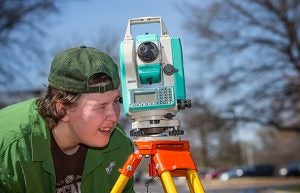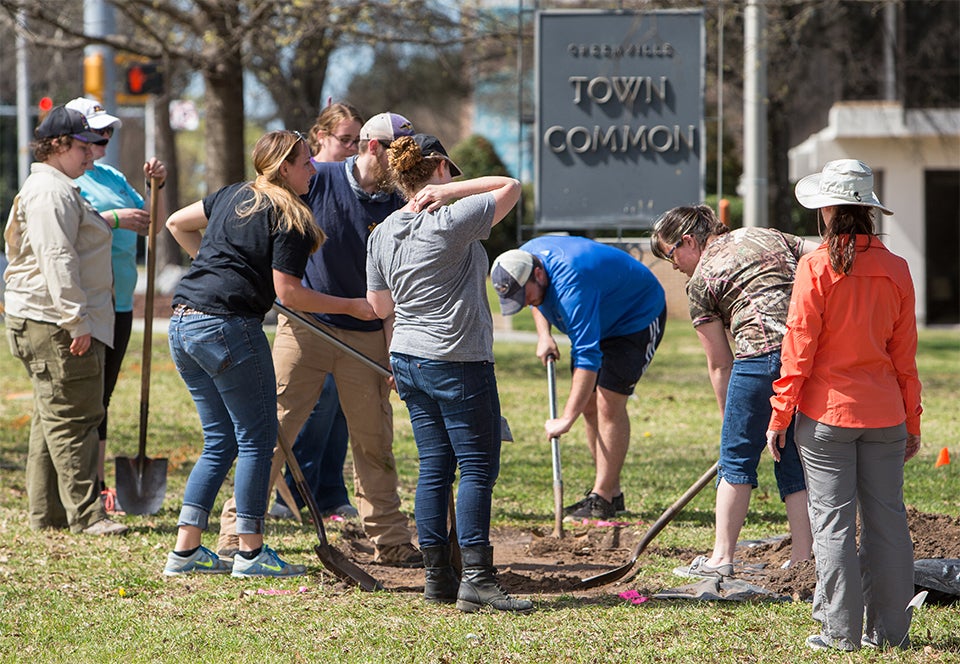HISTORY UNDER GROUND
Students survey former Sycamore Hill Baptist Church site
Students in ECU’s Department of Anthropology used ground-penetrating radar to search for objects under the grass of the Greenville Town Common. (Photos and video by Cliff Hollis)
Using ground-penetrating radar and targeted excavations, East Carolina University students investigated the site of the former Sycamore Hill Missionary Baptist Church on March 17-18, 2016. The church stood on the southwest corner of what is now the Greenville Town Common.
As Greenville works to develop future plans for its riverfront public area, it is important to know exactly what remains below the surface on the site, said Lamarco Morrison, parks planner for the Greenville Parks and Recreation Department. During public input sessions, he met with a group from the church who would like for the site to include a replica of the church’s bell tower as a memorial.
Charles Ewen, director of the Phelps Archaeology Laboratory at ECU, heard about the meetings and spoke with city officials about having his public archaeology class survey the site. Using ground-penetrating radar, the students marked “anomalies” – potential underground objects – with flags on the surface. The next day, they returned to dig in an effort to locate the church’s foundation.
“It took a long time to get this all approved, but that’s perfect for this class, because in real life that’s the pace these things go,” said Ewen. “For my class it couldn’t be a better project, because it’s very public. There are a lot of people who want to know what’s there; it’s not just an academic project.”
It was a win-win for the city to partner with ECU, said Morrison, because otherwise it would have had to hire a consultant to do the survey. “The students get hands-on experience, and we’ll get a report that helps us know what we need to do and how to proceed,” he said.
The church, which was built in 1917, was located in what was then a predominately black neighborhood that stretched from what is now the State Employees Credit Union past the east end of the Town Common, said Alton Harris, a lifelong member of the church who came to see the students at work.
In the 1960s, the houses in the neighborhood were cleared as part of an urban renewal project by the city. The residents, most of whom were renters, had little choice but to move to other areas, and by 1968 only the church remained.

Kristina Hill uses a total station to record the coordinates of possible underground objects.
“Some have said it was a slum area, but that’s not what it was,” said Harris. “If you look at the pictures from back then, there were some nice homes, nice lawns. They just wanted the land for development.”
Eventually the church moved into a building on Eighth Street, and in February 1969 someone started a fire that burned the building at Greene and First streets. The city purchased the property and relocated the graves. A stone memorial is all that stands above ground, but there could be portions of the church’s foundation below the surface, and some accounts claim that not all of the human remains were accounted for, said Sam Barber, the author of a book on the relocation of the cemetery.
“For the folks who lived in the neighborhood or are members of the church, it helps address their concerns about the site,” Ewen said of the survey project.
Ultimately, the students dug several shallow trenches but found little. One of the anomalies on the radar screen turned out to be a portion of an unused gas main. The largest single piece of building material they dug up was little more than half of a brick.
“We’ve found fragments of brick but no intact foundation,” said Ewen. “In the cemetery we didn’t see evidence of any remains. Either they moved everybody or there’s not much left to find after all these years, which is not unusual in the coastal plain, with its high water table and acidic soil.”
He had hoped to pinpoint the perimeter of the structure, but it appears the razing was thorough. Still, the information will be useful to the city as it makes plans, and the experience is valuable for the students.
“Radar isn’t the magic you see on TV,” Ewen said. “It’s hard to tell what you’re looking at, whether it’s a rock or part of a foundation or a tree root.
“And sometimes when you dig you don’t find much or anything at all.”
Jon Taylor, a junior history and anthropology major, said the project was a great opportunity to do field work.
“I’m a shovel-to-ground kind of guy,” he said. “I love the research and the scholarly aspect of it, but it’s great to be outside and do some physical labor.”
Taylor took the initiative to spend time in Joyner Library studying the history of the church and the neighborhood. He found several photographs of the site and correspondence between the church and the city that were useful in figuring out where to start.
“It looks like the south wall of the church was where the right-turn lane of First Street is now, and the ground level in the cemetery area was higher then,” he said.
The students got a chance to learn about a neighborhood that was gone before they were born.
“It connects us to the community, getting to see the city’s involvement and the history of the church,” said Amy Dubis, who is working on a master’s degree in anthropology. “You’re taking a class that really means something.”
For the church members, the important thing is to honor the memory of the church and the history of the neighborhood, said Harris. In addition to the bell tower, he hopes another sycamore tree, like the one for which the church was named, can be planted on the site.

Archaeology students excavate a trench in search of the foundation of Sycamore Hill Missionary Baptist Church.